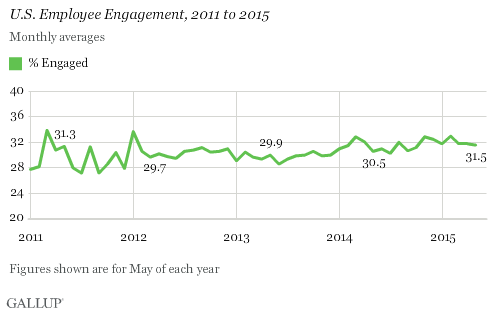U.S. Employee Engagement Flat in May
Wednesday, June 10th, 2015
The percentage of U.S. employees engaged in their jobs averaged 31.5% in May. This reading is on par with 31.7% recorded in January, March and April, but is the lowest monthly average for 2015.

The May 2015 estimate is based on Gallup U.S. Daily tracking interviews conducted with 6,976 adults working for an employer. Gallup categorizes workers as "engaged" based on their ratings of key workplace elements that predict important organizational performance outcomes. Engaged employees are involved in, enthusiastic about and committed to their work. Gallup's extensive research shows that employee engagement is strongly connected to business outcomes essential to an organization's financial success, such as productivity, profitability and customer engagement. Engaged employees drive the innovation, growth and revenue that their companies need.
Active Disengagement at Record Low
While employee engagement has been flat for much of the year, there has been recent movement in the percentage of "actively disengaged" employees. From April to May, active disengagement fell by one percentage point, from 17.5% to 16.5%. The latest percentage is the lowest for 2015 and ties December 2014 as the all-time lowest monthly figure for actively disengaged employees. Gallup began its daily survey of U.S. workplace engagement in January 2011 and has measured active disengagement as high as 21.8%.
Bottom Line
At 31.5%, the latest employee engagement figure reflects a workforce in which less than one-third of employees are engaged in their jobs. While the nation's employers reduced their percentage of actively disengaged employees in May, they did not increase their percentage of engaged workers. Instead, more employees moved to the "not engaged" zone. Here, employees are essentially "checked out." They sleepwalk through their workday and put time -- but not energy or passion -- into their work. These employees are less destructive and disruptive than actively disengaged employees, but they are not helping their organizations grow. To engage their workers, companies need to focus on putting high-performing managers in place and creating development strategies that maximize employees' strengths.


